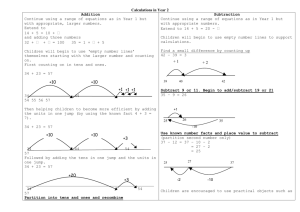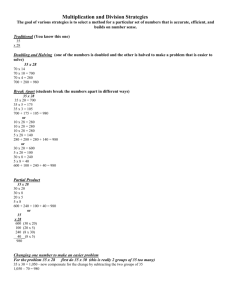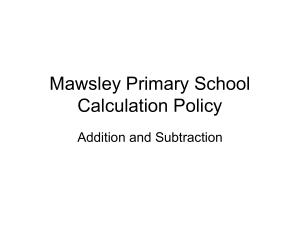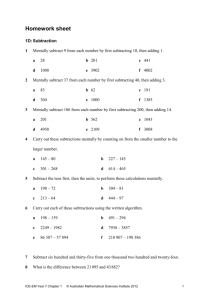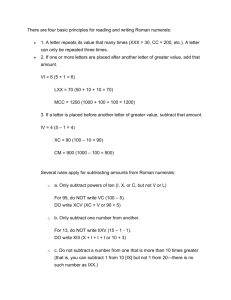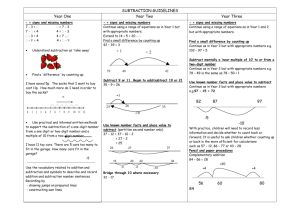Year 2 Teaching Sequence xxx
advertisement
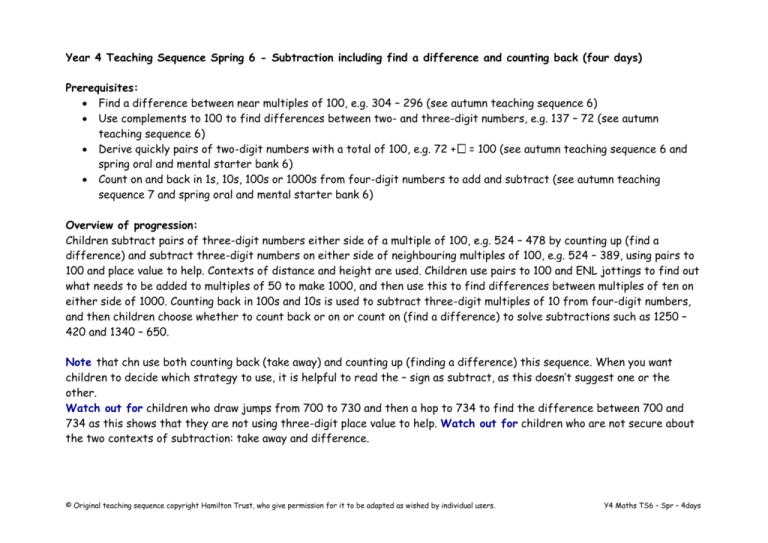
Year 4 Teaching Sequence Spring 6 - Subtraction including find a difference and counting back (four days) Prerequisites: Find a difference between near multiples of 100, e.g. 304 – 296 (see autumn teaching sequence 6) Use complements to 100 to find differences between two- and three-digit numbers, e.g. 137 – 72 (see autumn teaching sequence 6) Derive quickly pairs of two-digit numbers with a total of 100, e.g. 72 + = 100 (see autumn teaching sequence 6 and spring oral and mental starter bank 6) Count on and back in 1s, 10s, 100s or 1000s from four-digit numbers to add and subtract (see autumn teaching sequence 7 and spring oral and mental starter bank 6) Overview of progression: Children subtract pairs of three-digit numbers either side of a multiple of 100, e.g. 524 – 478 by counting up (find a difference) and subtract three-digit numbers on either side of neighbouring multiples of 100, e.g. 524 – 389, using pairs to 100 and place value to help. Contexts of distance and height are used. Children use pairs to 100 and ENL jottings to find out what needs to be added to multiples of 50 to make 1000, and then use this to find differences between multiples of ten on either side of 1000. Counting back in 100s and 10s is used to subtract three-digit multiples of 10 from four-digit numbers, and then children choose whether to count back or on or count on (find a difference) to solve subtractions such as 1250 – 420 and 1340 – 650. Note that chn use both counting back (take away) and counting up (finding a difference) this sequence. When you want children to decide which strategy to use, it is helpful to read the – sign as subtract, as this doesn’t suggest one or the other. Watch out for children who draw jumps from 700 to 730 and then a hop to 734 to find the difference between 700 and 734 as this shows that they are not using three-digit place value to help. Watch out for children who are not secure about the two contexts of subtraction: take away and difference. © Original teaching sequence copyright Hamilton Trust, who give permission for it to be adapted as wished by individual users. Y4 Maths TS6 – Spr – 4days Objectives: Count up to subtract near-multiples of 100, e.g. 524 – 478, 524 – 389, using pairs to 100 and place value to help, drawing own empty number line Derive quickly pairs of multiples of 50 with a total of 1000, e.g. 850 + = 1000, and use to subtract three- and four-digit multiples of 50, e.g. 1250 – 850 Subtract three-digit multiples of 10 by counting back in 100s and 10s, e.g. 1250 – 310 Choose whether to subtract by counting back or counting up, bridging the 100s Whole class Group activities Paired/indiv practice Resources Two groups of cyclists cycling from John O’Groats in northern Scotland to Lands End in Cornwall. The distance is 874 miles! One group plan to take 10 days to complete the ride, and the other group (who are less experienced at long distance cycling) are planning to take 14 days. Both are raising money for charity. On day 9, the first group have cycled 789 miles. How far have they got to cycle on their last day? How could we work this out? Draft a number line from 789 to 874. What important number lies between these two? 800 will be quite a landmark for them! What’s the difference between 789 and 800? How did you work that out? And between 800 and 874? That's easy, we can use place value! So what’s the difference between 789 and 874? Work it out, making a jotting on your whiteboards if it helps. Agree that they have 85 miles left to cycle. What subtraction could we write? What strategy have we used to find the difference? We are targeting 100s to find a difference and so we can call this T100. Ask children to work in pairs to use T100 to Group of 4-5 children Display the following list of prices, but with a fourth column headed ‘reduction’: Item Old Sale price price DVD £9.25 £7.69 CD £7.25 £5.99 Book £6.50 £4.89 Paint set £8.45 £7.79 Drawing pad £3.79 £2.45 Drawing pencils £4.25 £3.49 All these items have been reduced in the sale. Which item do you think has been reduced by the most? And the least? How much has the DVD been reduced by? How can we work this out? Together draft a line from £7.69 to £9.25. What are the important amounts between £7.69 and £9.25? What is the difference between £7.69 and £8? £8 and £9? £9 and £9.25? Mark these on the ENL jotting. So what’s the reduction? Put this in the table. Ask children to work in pairs to find the other reductions. Easier: Use the following table: Ask chn to practise targeting 100 (bridging 100) by working through the following: 523 – 489, 425 – 378, 615 – 586, 672 – 584, 565 – 448, 756 – 637, 745 – 688, 634 – 569, 925 – 867, 826 – 782, 537 – 473. Ask them to sketch ENLs to show their steps. Easier: Children find differences either side of a multiple of 100, and have beaded, then landmarked lines for support initially (see resources). They may need to draw a hop to the next multiple of ten from the smaller number, and then a jump to 100. Harder: Ask chn to do every other question. Challenge chn to find numbers between 400 and 600 with a difference of 48. Activity sheet of differences with number line support (see resources) © Original teaching sequence copyright Hamilton Trust, who give permission for it to be adapted as wished by individual users. Y4 Maths TS6 – Spr – 4days find the answers to 524 – 478 and 324 – 289, drawing jottings on their whiteboards. Take feedback. Another group of cyclists are cycling from John O’Groats to lands End. So far they have cycled 625 miles. How far have they got to cycle during the next 5 days? Draft a line to show 625 & 874. What important numbers lie between 625 and 874? This time there are two multiples of 100. Ask a child to mark on 700 & 800. How can we use this to find the difference? Ask children to find the difference between 625 & 700, between 700 & 800, then between 800 & 874. So this time we have 3 jumps to add up. What subtraction can we write? And what does each number in this subtraction mean? Agree that they represent distance they have cycled already, the target distance, and distance left to cycle. So roughly how many miles a day do they need to cycle? Ask children to work in pairs to use T100 to find the answers to 524 – 378 and 524 – 389, drawing jottings on their whiteboards. Take feedback. Item Old Sale price price DVD £8.25 £7.69 CD £6.25 £5.99 Book £5.50 £4.89 Paint set £8.45 £7.79 Drawing pad £3.29 £2.45 Drawing pencils £4.25 £3.49 Group of 4-5 children Write the following subtractions on the board: 518 - 347, 567 - 392, 548 - 329 Ask chn to discuss in pairs which they think will have the greatest answer and which will have the least. How did you decide? Draw out strategies such as rounding to the nearest multiple of ten and then subtracting. Give each pair a set of digit cards. Work with a partner to think of three additions with answers between 100 and 200, where every digit is different. They find the exact answer to check. Take feedback asking chn to explain how they came up with the two numbers. Easier: Children compare subtractions: 518 – 397, 567 – 492 and 548 – 429. They find subtractions with answer of less than 100. Ask chn to practise targeting 100 (bridging 100) by working through the following: 745 – 588, 723 – 489, 535 – 378, 615 – 476, 762 – 584, 755 – 448, 756 – 437, 634 – 469, 925 – 767, 826 – 682, 537 – 373. Ask them to sketch ENLs to show their steps. Easier: Children find differences either side of a multiple of 100 from the previous main practice session, and have landmarked lines for support initially (see resources). They may need to draw a hop to the next multiple of ten from the smaller number, and then a jump to 100. Harder: Ask chn to do every other question. Some children may be able to find the large difference by drawing just two jumps, e.g. solving 745 – 588 by drawing a jump from 588 to 600, then one large jump from 600 to 745. Challenge chn to find numbers between 300 and 600 with a difference of 148. © Original teaching sequence copyright Hamilton Trust, who give permission for it to be adapted as wished by individual users. 1-9 digit cards 0-1000 landmarked line (see resources) Y4 Maths TS6 – Spr – 4days Show a 0-1000 line (100s labelled, see resources). Ask a child to mark on 850. What do you add to 850 to make 1000? Record 850 + 150 = 1000. What do you think you might add to 750 to make 1000? What do you add to 75 to make 100? Does that help? Ask a child to mark on 750, and point out the 50, the 200 needed to make 1000. Work with a partner to find other pairs to 1000. Write the following on the board: 50 + = 1000 150 + = 1000 250 + = 1000 650 + = 1000 Ask questions about the list. So what is 1000 subtract 250? Subtract 350? What is the difference between 450 and 1000? Write the following subtractions on the board: 1200 – 850, 1350 – 900 and 1150 – 650. Talk to your partner about how we might find the answers to these subtractions. Take feedback and sketch a line from 850 to 1200. What important number is between 850 and 1200? And what is the difference between 850 and 1000? And between 1000 and 1200? So what is 1200 subtract 850? Ask children to work in pairs to use ENL jottings to find the answers to the other two subtractions. Group of 4-5 children Display the following table of heights of some of the mountains in the UK. Mountain Ben Nevis, Scotland Cairn Gorm, Scotland Snowdon, Wales Cadair Idris, Wales Scafell Pike, England Helvellyn, England Slieve Donard, NI Height to the nearest 10m 1340 1240 1090 890 980 950 850 What is the difference in height between the highest mountain in England and the highest mountain in Wales? How could we find out? Sketch a vertical line from 980 up to 1090. What important height is in between? What is the difference in height between 980 and 1000? And between 1000 and 1090? And what is the difference in height between the highest mountain in Scotland and the highest mountain in England? Sketch a vertical line to help. Repeat with other pairs of mountains whose heights are either side of 1000m. Harder: Use the following table instead: Mountain Ben Nevis, Scotland Cairn Gorm, Scotland Snowdon, Wales Cadair Idris, Wales Scafell Pike, England Helvellyn, England Slieve Donard, NI Ask children to write additions of three–digit numbers ending in 50 with a total of 1000. They then use this to help solve the following: 1050 – 850, 1200 – 650, 1350 – 450, 1300 – 550, 1650 – 750, 1500 – 850, 1400 – 550, 1100 – 350. Suggest children sketch ENL jottings to help. Harder: Children may not need to sketch jottings but may be able to work out the answers in their heads. 0-1000 landmarked line (see resources) Height to the nearest m 1344 1244 1085 893 978 950 852 © Original teaching sequence copyright Hamilton Trust, who give permission for it to be adapted as wished by individual users. Y4 Maths TS6 – Spr – 4days Write 1250 - 300 on the board. How could we work this out? Discuss this with your partner. Take feedback and draw out how we could either count up to find the difference between 300 and 1250 as in the previous session, or we could count back in 100s from 1250. Draft an ENL jotting to show 1250, a jump back of 100 to 1150, a jump back to 1050, and then 950. How could we work out 1250 subtract 310? Agree that we could count up from 310 to 1250 or we could count back in 100s to subtract 300, and then subtract 10. Ask children to work in pairs to use both strategies. Which was easier? Quicker? Share any jottings children have drawn to help keep track of counting back 300, then 10. Ask children to repeat with 1250 – 420, and then 1250 – 470. Group of 4-5 children Annie has scored 1300 points on a computer game. But, disaster! She loses 970 points! How many points does she have left? What do we need to do to the numbers in this word problem? What calculation can we write? Agree that we can write 1300 – 970. How would you normally work out this subtraction? (Count up to find a difference.) But the problem asks us to take the number away? Use both counting up and counting back to find the answer. The answer is the same, so even if it looks like we are taking away, if it’s easier to count up we can do that! Write the following problem on the flipchart: Ben has scored 1550 points, Annie has now scored 420 points. What’s the difference between their scores? What calculation can we write to solve this problem? And how would you prefer to work out this subtraction, by counting up or by counting back? Use both, conclude both give the same answer and ask children which they found easier/quicker for this calculation. Write similar problems on the flipchart and ask chn to discuss whether they would find it easier to use counting back or counting up to answer them. Easier: Some chn might not be ready for this idea, so just use word problems where the strategy suggested in the problem is the most efficient to solve it, i.e. just use this session to set ‘take away’ and ‘difference’ in context. Children practise counting back in 100s, then 10s to work out the following drawing ENL jottings where necessary: 1750 – 220, 1530 – 310, 1350 – 410, 1270 – 320, 1180 – 210, 1450 – 520, 1870 – 350, 1290 – 450. They then choose to count back or to count up (find a difference) to work out the following: 1420 – 580, 1250 – 420, 1340 – 650. Easier: Children draw ENL jottings to count back 100s, then 10s for the first set of calculations only. Harder: Ask children also to think of two more calculations that they would solve by counting back and two for which they would count up. © Original teaching sequence copyright Hamilton Trust, who give permission for it to be adapted as wished by individual users. Y4 Maths TS6 – Spr – 4days
